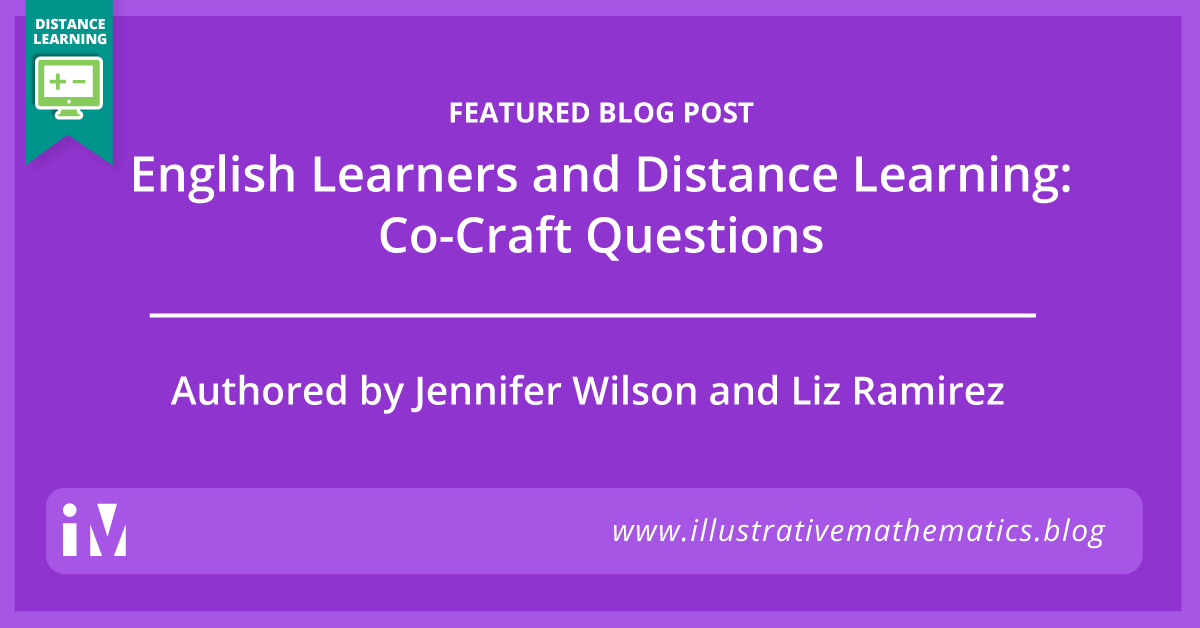By Jennifer Wilson and Liz Ramirez
We envision creating a world where learners know, use, and enjoy mathematics. Knowing and using math goes beyond calculating and evaluating. We create purposeful opportunities for students to engage in sense-making and use language to negotiate meaning with their peers. This calls for a language-rich environment where there’s space for all students to participate in argumentation and explanation.
What do these conversations look like now that we are no longer sharing physical space together? And how do we support our multilingual students who are gaining proficiency with English?
In this series of posts, we continue to consider how to “strengthen the opportunities and supports for helping students to describe clearly their mathematical thinking to others, orally, visually, and in writing” by looking at three Math Language Routines (MLRs). You can learn more about the MLRs here. The first post in this series was about enhancing access, and the second post was about MLR 3 Clarify, Critique, Correct.
In this post we will explore MLR 5 Co-Craft Questions.
MLR5 Co-Craft Questions
The Co-Craft Questions routine allows students to get inside of a context before feeling pressure to produce answers, and creates space for students to produce the language of mathematical questions themselves.
How it happens:
- Hook: Present a context or a stem for a problem. The hook can also be a picture, video, or list of interesting facts.
- Students Write Questions: Students write down possible mathematical questions that could be asked about the situation.
- Students Compare Questions: Students compare questions with a partner. Select questions to share and discuss with the whole class.
- Actual Question(s) Revealed: Reveal the questions students are expected to work on. Alternatively, select from the list of student generated questions.
Here’s an example from Geometry Unit 5 Lesson 11.
Students begin with some quiet think time to study the image below and consider the prompt: “The building on the left side of the picture is called the Cayan Tower. What mathematical questions could be asked about the tower?”

As we begin this activity, we can anticipate the kinds of responses our students might give. Some responses to this prompt might be:
- How tall is the building? How many floors?
- What are the dimensions of the building?
- Does twisting the building lessen the space inside?
- How long would it take to clean the windows?
- How does the twisting work?
- Are all floors the same size?
Let’s consider, What happens when we pay attention to language? In this routine the class reflects on the list of questions generated by their peers. English learners benefit from this attention to the language of mathematical questions. This routine gives students space to connect context and vocabulary as well as recognize the structure of mathematical questions grounded in the context.
Here is the support for English language learners provided for this activity.
| Support for English Language Learners Speaking, Reading: MLR5 Co-Craft Questions. Use this routine to increase awareness of the language used to talk about the cross sections and volume of the Cayan Tower. Before revealing the questions in this activity, display the image of the Cayan Tower along with the statement: “The building on the left side of the picture is called the Cayan Tower,” and ask students to write down possible mathematical questions that could be asked about the tower. Invite students to compare their questions before revealing the actual questions. Listen for and amplify any questions about the cross sections and volume of the Cayan Tower. For example, “What is the area of the base of the Cayan Tower?” and “What is the volume of the Cayan Tower?” Design Principle(s): Maximize meta-awareness; Support sense-making |
Based on this suggestion, a teacher can lift student responses to guide interest towards the learning goal of applying what they have learned about prisms and cross sections to a context.
What might this look like during distance learning?
This routine could be facilitated either synchronously or asynchronously. Either way, there needs to be opportunity for students to review and compare questions, and to reflect on the experience. In an asynchronous format, students might submit questions, and then the teacher shares out later with a document or a video. This gives students an additional opportunity to interact with—and reflect on—the questions.
The following is a story of an experience with a group of 5th grade students in a virtual class meeting. In fact, it was the teacher’s second virtual meeting with the group, and the focus was to foster a sense of mathematical community.
The group used this activity from IM Talking Math K–5. (You can access IM Talking Math 6–8 in English here and in Spanish here.)

The session began by displaying the image and posing the question above. Students were invited to pose their questions in the chat box. Here are some of the responses:
Evelyn: How many are there?
Taner: How many pink and white gloves are there? Solve and show your work with a model and equation.
George: Are there different colors and materials?
Noticing the variety of responses, the teacher asked her students, “What makes a question mathematical?”
Students gravitated to Taner’s response, referencing tasks they had completed in class before. She then asked students, “What makes Evelyn’s question mathematical?” They responded, we can count the gloves and get the answer.
The teacher then turned to George’s questions and asked again, “What makes a question mathematical?” After some quiet think time, students highlighted that they could sort and count the number of different colors they saw, and maybe even do the same for the different materials.
By focusing on language, the teacher created an opportunity for students to go beyond just answering the given question. This conversation gave space for students to engage with the context as well develop a sense of the types of questions that invite folks to work with quantities, before the teacher posed the next question to her students: “Explain where you see the equation in the picture.”
Next Steps
We would love to learn alongside you. How have you used MLR5 with your students during distance learning? Share your Co-Craft Questions prompt, and, if possible, student work, at #LearnWithIM.
Special thanks to Vanessa Cerrahoglu and her students for sharing their learning with us.
